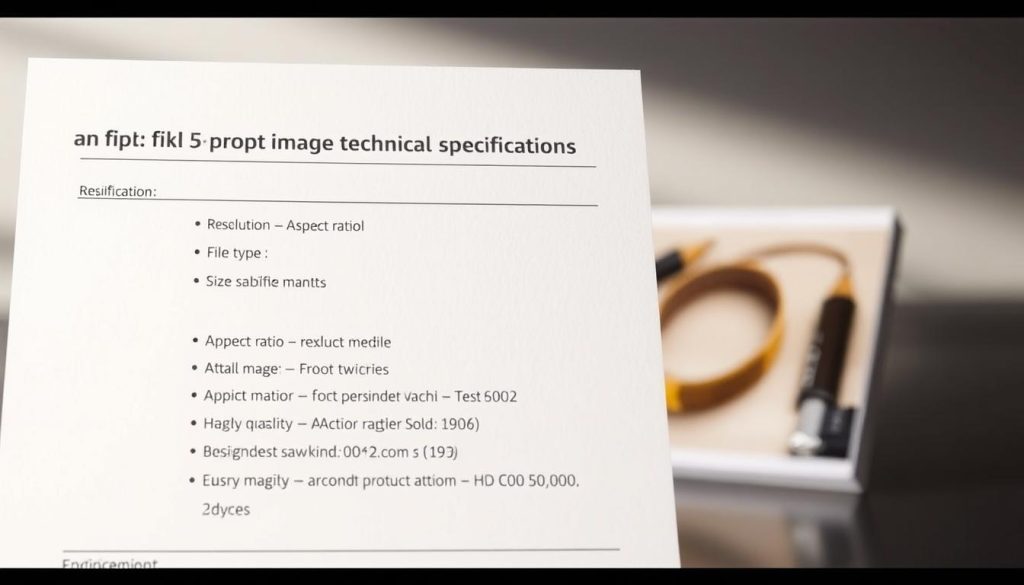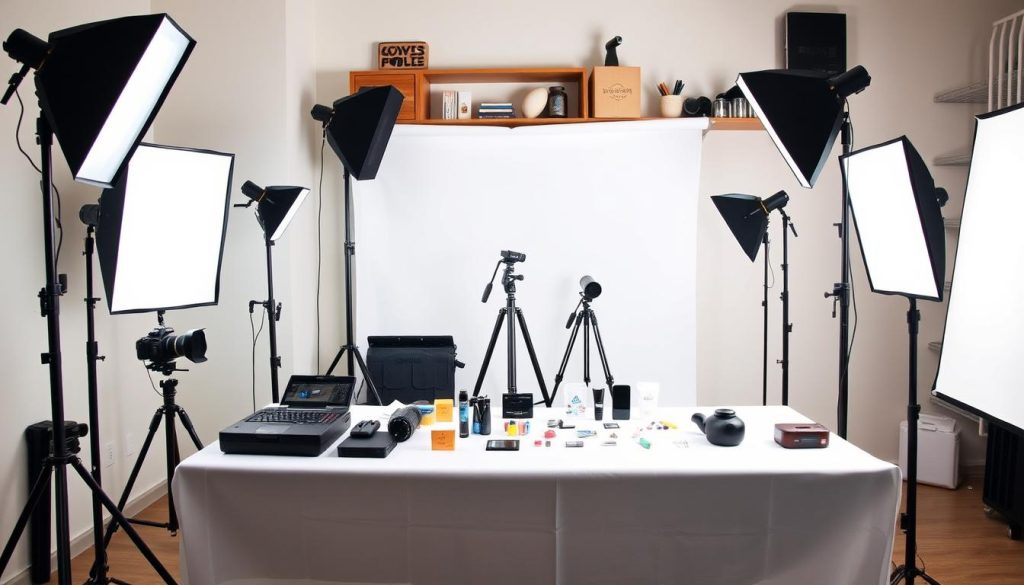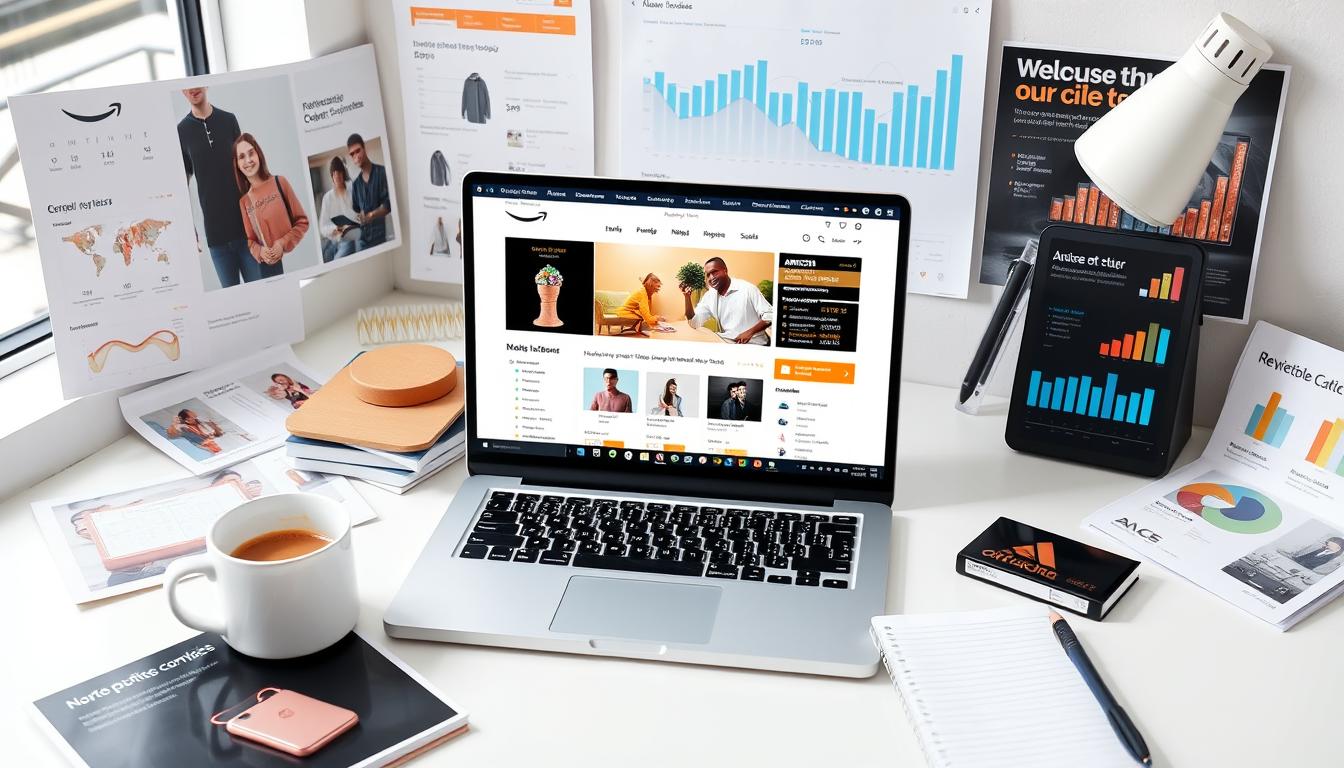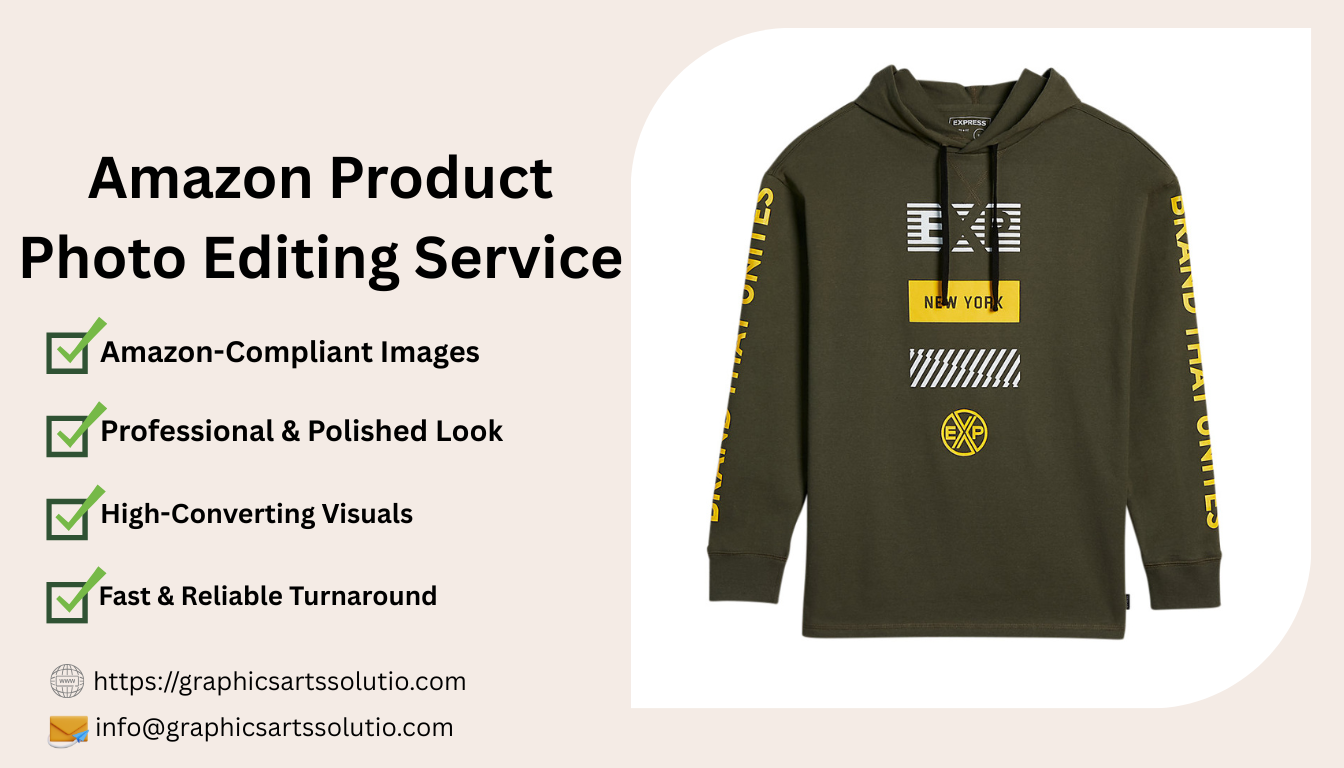Many Amazon shoppers use their phones to buy products. So, it’s key to have great, phone-friendly images.
Most people shop on Amazon with their phones. So, making beautiful, phone-ready images is a must. This article will show you how to make mobile-optimized images to help sell more and get noticed on Amazon.
We’ll talk about Amazon’s image rules and how to improve them. You’ll learn how to make your listings pop and boost your image optimization plan.
The Impact of Mobile Shopping on Amazon Listings
Mobile shopping has changed how we look at Amazon listings. It’s key for sellers to know about mobile shopping. This helps them make their listings better and sell more.
Mobile Shopping Statistics and Trends
More and more people shop on Amazon using their phones. Over 70% of Amazon shoppers use mobile devices to shop. This is because mobile shopping is easy and flexible, letting people shop anytime, anywhere.
Mobile-exclusive deals and better product images are big trends. Sellers need to keep up with these to stay ahead.

How Image Quality Affects Conversion Rates
Good product images are very important for sales on Amazon. High-quality images make shopping better and help sell more. On phones, where space is tight, images need to be clear and good.
To get better at selling, make sure your images are sharp and well-lit. This helps increase sales. It’s also important to keep images small so they load fast on phones.
Amazon's Product Images Requirements and Guidelines
To make great product images for Amazon, sellers need to know the rules. Amazon wants all images to look the same and be of high quality. Following these guidelines helps sellers look professional and compete well.
Technical Specifications for Image Uploads
Amazon has specific rules for image uploads. They want JPEG or TIFF files with a minimum of 1000 pixels on the longest side. Images should be in RGB color and have a white background. It’s important for images to be clear and not blurry.
Technical specifications include:
- File format: JPEG or TIFF
- Minimum resolution: 1000 pixels on the longest side
- Color mode: RGB
- Background: White

Mobile-Specific Display Requirements
Most Amazon shoppers use mobile devices. So, making images work well on small screens is key. Images should have a clear subject and not too much background. Lifestyle images help show how the product is used.
Best practices for mobile display include:
- Using clear and concise product images
- Minimizing background clutter
- Incorporating lifestyle and contextual images
Essential Equipment for Professional Amazon Photography
For top-notch Amazon photos, you need the right gear. Sellers must pick the best tools to show off products well.
Camera Options: From Smartphones to DSLRs
There are many camera choices, from phones to DSLRs. Smartphones are easy to use and take great photos. They’re a good first choice.
For more control and quality, DSLRs or mirrorless cameras are best. They let you adjust focus, exposure, and more.
Lighting Equipment for Consistent Results
Good lighting is key for product photos. Softbox lights and LED panels give soft, even light. They make sure products look good and are well-lit.
Tripods, Backdrops, and Accessories
You also need tripods for steady shots, backdrops for clean backgrounds, and reflectors for light control. These tools help make your photos better.
| Equipment | Purpose | Benefits |
|---|---|---|
| DSLR/Mirrorless Camera | Capturing high-quality images | Better control over focus, exposure, and depth of field |
| Softbox Lights/LED Panels | Providing even lighting | Reduces harsh shadows and reflections |
| Tripod | Stabilizing the camera | Prevents camera shake and blur |

Setting Up Your DIY Product Photography Studio
Setting up a DIY product photography studio at home can make your Amazon images better. A dedicated space means your photos will look the same and professional.
Creating an Effective Lighting Environment
Good lighting is key for great product photos. Soft, diffused lighting cuts down on harsh shadows and reflections. Use a softbox or a light tent for this.
Place your lights at a 45-degree angle to the product. This reduces glare and reflections. Try different setups to see what works best for your items.

Backdrop Selection and Preparation
Picking the right backdrop is important for nice product images. A clean, simple background makes your product pop. Think about using a white or light-colored backdrop for a neutral look.
You can use paper or fabric backdrops. Make sure to iron or smooth out any wrinkles for a smooth surface.
With a well-set-up DIY studio, you can take photos that show off your products well. This will make your Amazon listings better and help build your brand.
Types of Product Images for Amazon Listings
To make your Amazon listing pop, you need to know about different image types. Amazon lets you use many kinds of images to make your product stand out. Each type has its own role in showing off your product to shoppers.
Main Product Images (White Background)
The main image of your product is key. It’s usually on a white background. This image should be clear and show your product from the front. A white background makes your product the main focus, helping customers see what they’re buying.
Lifestyle and Contextual Images
Lifestyle images show your product in action. They help customers see how it fits into their lives. These images are great for products used in different ways or that look good. They help create a connection with buyers.
Detail and Feature Close-ups
Close-ups highlight special parts of your product. They let customers see details they might miss in the main image. These images build trust and help customers make smart choices.
Size Reference and Scale Demonstrations
Size matters for some products. Images showing your product’s size compared to everyday items help. They give customers a clear idea of size, reducing returns and boosting happiness.
Using a variety of images makes your Amazon listing better. Include main images, lifestyle shots, close-ups, and size comparisons. This mix attracts more customers and makes your listing more engaging.
Step-by-Step Guide to Shooting Mobile-Optimized Product Images
Mobile-optimized product images are now a must for Amazon success. Most Amazon shoppers use mobile devices. So, it’s key to make sure your images work well on small screens.
Positioning Products for Maximum Impact
To grab the attention of buyers, place your product to show off its best sides. Choose a clean and simple background to keep focus on the product. Try different angles and ways to arrange the product for the best look.
- Put the product in the middle of the picture
- Use a tripod for steady shots
- Try different ways to show the product
Camera Settings for Clarity and Detail
For top-notch images, adjust your camera settings right. Lower ISO and wider aperture help get a clear, sharp image. This makes the product stand out.
- Keep ISO low (100-400) for clear images
- Set aperture to f/8 or f/11 for sharpness
- Change shutter speed for the right light
Capturing Multiple Angles and Perspectives
Showing your product from different angles helps customers see its features. Take pictures from various sides, including close-ups of key features and lifestyle shots of the product in use.
- Get a main product image with a white background
- Take lifestyle images of the product in use
- Include detail shots of important features
Techniques for Challenging Products (Reflective, Small, Transparent)
Some products need special tricks to show their details well. For shiny surfaces, use a polarizing filter to cut down on glare. For tiny or clear items, think about using a macro lens or extension tubes to see the small details.
- Use a polarizing filter for shiny surfaces
- Use a macro lens for small or detailed items
- Try backlighting for clear items
Post-Processing Techniques for Mobile Visibility
Post-processing techniques are key to making product images look great on mobile screens. Using the right editing tools can make images better. This leads to more sales on Amazon.
Essential Editing Software Options
First, pick the right editing software. Adobe Photoshop and Lightroom are top choices. They have cool tools for making images better. For easier use, try Canva or Skylum Luminar.
Optimizing Image Dimensions for Mobile Screens
It’s important to make images the right size for mobile. Amazon says use images that are at least 1000 x 1000 pixels. This makes them clear on big mobile screens. But, they should also load fast.
Color Correction and Enhancement
Changing colors can really help product images. You can adjust white balance, exposure, and saturation. This makes the product look better and more appealing.
File Compression Without Quality Loss
Compressing files is key for fast loading on mobile. Use RGB color mode and JPEG compression to shrink files. Tools like TinyPNG and ImageOptim help keep quality high while making files smaller.
Common Mistakes in Amazon Product Images
To stand out on Amazon, it’s key to know and avoid common image mistakes. Even with good plans, mistakes can happen. These can hurt your product’s visibility and sales.
Poor Lighting and Distracting Shadows
Poor lighting can make your product look bad. Shadows can also pull attention away from your product. It’s important to have proper lighting to show your product well.
Inconsistent Style Across Product Listings
Keeping a consistent style in your listings is crucial. It helps with branding and customer recognition. If styles are not the same, it can confuse customers and weaken your brand.
Cluttered Backgrounds and Distractions
Cluttered backgrounds and distractions can make your product less appealing. It’s important to keep the background simple. This helps your product stand out.
Failing to Test on Mobile Devices
Most Amazon shoppers use mobile devices. Failing to test your images on mobile can lead to a bad experience. Make sure your images look good on smaller screens to boost sales.
Testing and Optimizing Images Across Mobile Devices
Most Amazon shoppers use mobile devices. So, making your product images mobile-friendly is key. You must test and optimize them for different devices.
Using Amazon's Mobile Preview Tools
Amazon has tools to show how your images look on mobile devices. It’s important to use these tools to find any problems before your images are live. You can adjust your images to meet Amazon’s standards and look good on small screens.
To use Amazon’s tools, go to your product listing and find the preview option. This lets you see how your images look on different devices. It helps you make the best choices for image optimization.
Cross-Device Testing Methods
Testing your images on various mobile devices is also key. This means checking them on different phones and tablets. It helps find any display issues or problems.
Testing on many devices ensures a great experience for all customers, no matter how they view your products.
A/B Testing Images for Conversion Optimization
A/B testing, or split testing, is great for improving your images. It lets you test two versions of an image to see which one works better. This way, you can choose the best image for your product.
This method helps you make smart choices about your images. It can lead to more sales and happy customers.
Conclusion
Creating good product images for Amazon listings is very important today. We live in a world where most people shop on their phones. Knowing what Amazon wants and using the right camera can really help.
Mobile optimization is very important. Most Amazon shoppers use their phones. Making sure your images look good on phones can really help your sales.
By following the tips in this article, you can make your product images stand out. This can lead to more customers, more sales, and a better spot in the Amazon marketplace.
FAQ
What are the ideal dimensions for Amazon product images?
Amazon wants your images to be at least 1000 pixels on the longest side. This makes sure they look good on phones.
What file format should I use for my Amazon product images?
You can use TIFF, JPEG, PNG, or GIF for your images. But, JPEG is the best choice for product pictures.
How do I optimize my product images for mobile devices?
Make sure your images are clear and big enough for phones. Use simple backgrounds and test them on different phones.
Can I use lifestyle images in my Amazon product listings?
Yes, lifestyle images are great for showing how your product is used. They help customers see the benefits.
What are the most common mistakes to avoid when creating Amazon product images?
Don’t use bad lighting or cluttered backgrounds. Also, make sure your images look good on phones.
How can I ensure my product images are consistent across listings?
Keep your images the same style and format. Use the same background and lighting for all your pictures.
What is the importance of testing my product images on mobile devices?
Testing on phones makes sure your images are clear and easy to see. This can help you sell more.
Can I use Amazon’s mobile preview tools to test my product images?
Yes, Amazon has tools to show how your images look on phones. This helps you make changes if needed.
How can I improve the visibility of my product images on mobile devices?
Use bright colors and clear pictures. Make sure your images fit well on phone screens.
What are the benefits of using A/B testing for my product images?
A/B testing shows you which images work best. This helps you make your listings better and sell more.




